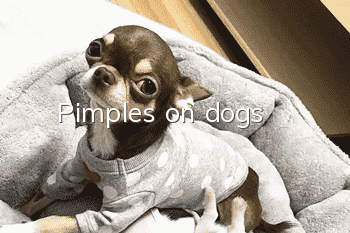What should you pay attention to after giving birth to a Labrador?

Labrador postpartum care
1. The female dog’s vulva, tail and breasts should be washed and dried with warm water; contaminated mattresses should be replaced and kept warm.
2. Female dogs become very ferocious after giving birth to protect their puppies. Female dogs that have just given birth should be kept quiet for 8-24 hours. Strangers should not approach to avoid harassment of the female dog, which may cause the female dog to become neurotic and occur. Consequences of biting people or swallowing puppies.
3. Female dogs that have just given birth generally do not eat. They can be fed some glucose water first, and then add some eggs and milk after 5-6 hours, until they officially start feeding 24 hours later. At this time, it is best to feed some food that is good in palatability and easy to digest. In the first few days, feed nutritious porridge-like feed, such as milk mixed with eggs, meat porridge, etc., with small and frequent meals, and gradually feed drier feed after a week.
4. Pay attention to the nursing situation of the female dog. If she does not breastfeed her puppies, find out whether she is lacking milk or is sick, and take corresponding measures in a timely manner. Female dogs with low lactation can be fed milk or pig's trotter soup, fish soup, pig lung soup, etc. to increase lactation.
5. Some female dogs have poor maternal qualities and are unwilling to take care of their puppies. They must be severely punished and forced to breastfeed their puppies. For bitches that don't care about their puppies, you can also deliberately catch one of the puppies and make it scream, which may awaken the bitch's maternal instinct. In addition, the puppies are not moving well at this time, so you should always prevent the mother dog from squeezing the puppies. If you hear the short screams of the puppies, you should go to check immediately and take out the squeezed puppies in time.
6. Do a good job of anti-freezing and keeping warm the puppies in winter. Bedding and litter can be added, and cold-proof curtains can be hung at the door of the kennel. If the temperature of the kennel is too low, you can also use an infrared pad to indicate that the temperature is too high. Accordingly, you can adjust the appropriate temperature for the puppies.
Note: In order to stimulate the excretion of the puppies, the mother dog must lick the buttocks of the puppies with her tongue. If the mother dog does not lick, apply cream near the anus of the puppies to induce the mother dog to lick.
Puppy care
1. A puppy takes about 45 days from birth to weaning. The main things to pay attention to during this period are: keeping warm, preventing pressure, and eating enough colostrum.
(Newborn puppies cannot produce antibodies in their bodies, so they should try to eat enough colostrum.)
2. Pay attention to development. It is best to weigh yourself regularly. Generally, within 5 days after a puppy is born, the daily weight gain will be about 50 grams on average. From 6 to 10 days, the daily weight gain will be about 70 grams. From 11 days onwards, if the mother's milk is insufficient, the puppy's weight will decrease. The growth rate may decrease. Regular weighing can help you understand the mother's lactation from changes in weight.ability to decide whether to artificially supplement milk.
Milk supplement: Mainly fresh milk or goat milk. After boiling and sterilizing, the baby should be fed with a bottle at a temperature of 20-30 degrees Celsius.
Amount of milk supplement: Within 15 days, 50 ml of milk per animal. 100ml of milk supplement on the 15th-20th day. After 20 days, add 200 ml of milk. 3-4 times a day. (If fresh milk is not available, milk powder can be substituted with water.)
3. The bodies of lactating puppies are relatively fragile. If there is insufficient nutrition and poor environmental conditions, it can easily cause disease and death. Therefore, in addition to doing a good job in breastfeeding, it is very important to strengthen daily management. In the first 4 days after giving birth, the owner should always check the mother dog for any crushing of the puppies and the lactation status.
After 5 days, you can take advantage of the good wind and warm weather to take the puppies outdoors to bask in the sun with the mother dogs, usually twice a day, for about half an hour each time, so that they can breathe fresh air; Ultraviolet rays kill bacteria on puppies; promote bone development and prevent the occurrence of osteomalacia. When the puppies can walk, they can be put for a walk outdoors. The time should be short at first and gradually extended later.
Around 13 days, puppies can open their eyes. At this time, strong light stimulation should be avoided to avoid damage to the eyes.
After 20 days, if the weather is fine, the mother dog and her puppies can be allowed to move around the hospital for any time, and they can be moved into the delivery room at night or on rainy days; if the puppies get wet in the rain, use a dry towel immediately Dry it and put it back in the nest. Keep it warm to prevent colds.
Trim the puppies’ toenails once every 20 days to avoid scratching the female dog’s breasts during breastfeeding.
At 30 days, use deworming net to deworm, and then once a month. Dirt is easy to stick to the body of the puppies. The mother dog can remove it at any time in the early stage, but then ignore it. The owner needs to brush and bathe the puppies frequently, once every 2-3 days, to keep the body clean. In short, the feeding and management of lactating puppies should be: adequate nutrition, ensure sleep, appropriate activities, and good hygiene.
- Can’t you train a Husky? Husky training tips!
- Dog hepatitis symptoms and prevention measures
- What is canine distemper? Symptoms and treatment of canine distemper in dogs!
- Things to note when raising a French bulldog
- How to euthanize a dog
- A must-read for poop scrapers, 14 symptoms of sick pets at home!
- A few pictures to help you easily determine whether your dog or cat’s weight is standard
- How to give injections to dogs? What you need to know about dog vaccinations - The pet next door
- How to supplement calcium for Rottweiler puppies?
- Symptoms of meningitis in dogs



